Improving the Earthquake Resilience of Primary Schools in the Border Regions of Neighbouring Countries
Abstract
:1. Introduction
2. Developing a Computational Strategy for the Seismic Assessment
2.1. Schools Database
2.1.1. Primary Schools in the Algarve Region (Portugal)
2.1.2. Primary Schools in the Huelva Region (Spain)
2.2. Seismic Action
2.2.1. Code-Based Seismic Action
2.2.2. Earthquake Scenarios
2.3. Vulnerability Evaluation
2.3.1. Capacity Curves Obtained for the Algarve Region (Portugal)
2.3.2. Capacity Curves Obtained for the Huelva Region (Spain)
2.4. Ranking School Buildings
3. Retrofitting of Pilot School Buildings
3.1. The Brancanes Primary School (Olhão, Algarve, Portugal)
3.2. The Los Lanos Primary School (Almonte, Huelva, Spain)
4. Risk Communication
5. Results and Discussion
6. Conclusions
- It is feasible to carry out the evaluation of the seismic safety of a large number of buildings using the analysis methods established in the EC8-3, when using dedicated software, such as the one that was developed for the project;
- Using this approach, it has been possible to verify the great influence of the selection of the GMPEs on the estimation of the collapse ratio of the school buildings. Therefore, the real degree of damage expected for the earthquake scenarios tested is not certain. Nevertheless, it would probably be within the upper and lower limits obtained;
- The seismic retrofitting of two pilot schools made it possible to observe the main execution errors of the most usual solutions adopted for masonry buildings. Moreover, it stressed the need to provide training courses to all types of workers involved in this type of work and not to just focus attention on structural designers;
- The resources and educational material developed, as well as the training actions carried out with teachers, were a great success. This shows that this procedure is one of the best ways to create a more resilient society to the effects of earthquakes;
- The PERSISTAH project can help government agencies to prepare a vulnerability reduction plan, promoting structural and non-structural mitigation, to enhance the safety of existing schools and reduce their vulnerability;
- The fact that PERSISTAH is a cross-border project allowed a better understanding of the differences between the seismic codes of Portugal and Spain, in particular for school buildings. Therefore, it is desirable to carry out more joint studies concerning the seismic hazard of these regions.
Author Contributions
Funding
Institutional Review Board Statement
Informed Consent Statement
Data Availability Statement
Acknowledgments
Conflicts of Interest
References
- UN. The 17 Sustainable Development Goals (SDGs). United Nations. Available online: https://sdgs.un.org/goals (accessed on 20 December 2021).
- Mendonça, D.; Amorim, I.; Kagohara, M. An historical perspective on community resilience: The case of the 1755 Lisbon Earthquake. Int. J. Disaster Risk Reduct. 2019, 34, 363–374. [Google Scholar] [CrossRef]
- Winstanley, A.; Hepi, M.; Wood, D. Resilience? Contested meanings and experiences in post-disaster Christchurch, New Zealand. Kōtuitui N. Z. J. Soc. Sci. Online 2015, 10, 126–134. [Google Scholar] [CrossRef] [Green Version]
- Xi, Y.; Yu, H.; Yao, Y.; Peng, K.; Wang, Y.; Chen, R. Post-traumatic stress disorder and the role of resilience, social support, anxiety and depression after the Jiuzhaigou earthquake: A structural equation model. Asian J. Psychiatry 2020, 49, 101958. [Google Scholar] [CrossRef] [PubMed]
- Bal, İ.E.; Smyrou, E. Simulation of the earthquake-induced collapse of a school building in Turkey in 2011 Van Earthquake. Bull. Earthq. Eng. 2016, 14, 3509–3528. [Google Scholar] [CrossRef]
- Chen, H.; Xie, Q.; Lan, R.; Li, Z.; Xu, C.; Yu, S. Seismic damage to schools subjected to Nepal earthquakes, 2015. Nat. Hazards 2017, 88, 247–284. [Google Scholar] [CrossRef] [Green Version]
- Di Ludovico, M.; Digrisolo, A.; Moroni, C.; Graziotti, F.; Manfredi, V.; Prota, A.; Dolce, M.; Manfredi, G. Remarks on damage and response of school buildings after the Central Italy earthquake sequence. Bull. Earthq. Eng. 2019, 17, 5679–5700. [Google Scholar] [CrossRef]
- Kabeyasawa, T. Damages to RC school buildings and lessons from the 2011 East Japan earthquake. Bull. Earthq. Eng. 2017, 15, 535–553. [Google Scholar] [CrossRef]
- Oyguc, R. Seismic performance of RC school buildings after 2011 Van earthquakes. Bull. Earthq. Eng. 2016, 14, 821–847. [Google Scholar] [CrossRef]
- Angelier, J.; Lee, J.-C.; Hu, J.-C.; Chu, H.-T. Three-dimensional deformation along the rupture trace of the September 21st, 1999, Taiwan earthquake: A case study in the Kuangfu school. J. Struct. Geol. 2003, 25, 351–370. [Google Scholar] [CrossRef]
- Global_Education_Cluster. Disaster Risk Reduction in Education in Emergencies—A Guidance Note for Education Clusters and Sector Coordination Groups. Available online: https://reliefweb.int/attachments/596e560e-cf6c-3a3c-ab27-576212068dbc/Full_report.pdf (accessed on 5 November 2021).
- Calvi, G.M.; Pinho, R.; Magenes, G.; Bommer, J.J.; Restrepo-Vélez, L.F.; Crowley, H. Development of seismic vulnerability assessment methodologies over the past 30 years. ISET J. Earthq. Technol. 2006, 43, 75–104. [Google Scholar]
- Maio, R.; Estêvão, J.M.C.; Ferreira, T.M.; Vicente, R. Casting a new light on the seismic risk assessment of stone masonry buildings located within historic centres. Structures 2020, 25, 578–592. [Google Scholar] [CrossRef]
- Candeias, P.; Vicente, M.; Rupakhety, R.; Lopes, M.; Ferreira, M.A.; Oliveira, C.S. Seismic Performance of Non-structural Elements Assessed Through Shake Table Tests: The KnowRISK Room Set-Up. In Proceedings of the International Conference on Earthquake Engineering and Structural Dynamics, Cham, Iceland, 12–14 June 2017; pp. 293–307. [Google Scholar] [CrossRef]
- Mutch, C. The role of schools in disaster preparedness, response and recovery: What can we learn from the literature? Pastor. Care Educ. 2014, 32, 5–22. [Google Scholar] [CrossRef]
- Mutch, C. Leadership in times of crisis: Dispositional, relational and contextual factors influencing school principals’ actions. Int. J. Disaster Risk Reduct. 2015, 14, 186–194. [Google Scholar] [CrossRef]
- Notman, R. Seismic Leadership, Hope, and Resiliency: Stories of Two Christchurch Schools Post-Earthquake. Leadersh. Policy Sch. 2015, 14, 437–459. [Google Scholar] [CrossRef]
- Tan, K.T.; Abdul Razak, H.; Lu, D.; Li, Y. Seismic response of a four-storey RC school building with masonry-infilled walls. Nat. Hazards 2015, 78, 141–153. [Google Scholar] [CrossRef]
- El-Betar, S.A. Seismic vulnerability evaluation of existing R.C. buildings. HBRC J. 2018, 14, 189–197. [Google Scholar] [CrossRef] [Green Version]
- Korkmaz, M.; Ozdemir, M.A.; Kavali, E.; Cakir, F. Performance-based assessment of multi-story unreinforced masonry buildings: The case of historical Khatib School in Erzurum, Turkey. Eng. Fail. Anal. 2018, 94, 195–213. [Google Scholar] [CrossRef]
- O’Reilly, G.J.; Perrone, D.; Fox, M.; Monteiro, R.; Filiatrault, A. Seismic assessment and loss estimation of existing school buildings in Italy. Eng. Struct. 2018, 168, 142–162. [Google Scholar] [CrossRef]
- Perrone, D.; O’Reilly, G.J.; Monteiro, R.; Filiatrault, A. Assessing seismic risk in typical Italian school buildings: From in-situ survey to loss estimation. Int. J. Disaster Risk Reduct. 2020, 44, 101448. [Google Scholar] [CrossRef]
- Pan, H.; Kusunoki, K. Aftershock damage prediction of reinforced-concrete buildings using capacity spectrum assessments. Soil Dyn. Earthq. Eng. 2020, 129, 105952. [Google Scholar] [CrossRef]
- Clementi, F.; Gazzani, V.; Poiani, M.; Lenci, S. Assessment of seismic behaviour of heritage masonry buildings using numerical modelling. J. Build. Eng. 2016, 8, 29–47. [Google Scholar] [CrossRef]
- Hancilar, U.; Çaktı, E.; Erdik, M.; Franco, G.E.; Deodatis, G. Earthquake vulnerability of school buildings: Probabilistic structural fragility analyses. Soil Dyn. Earthq. Eng. 2014, 67, 169–178. [Google Scholar] [CrossRef]
- Tang, B.; Lu, X.; Ye, L.; Shi, W. Evaluation of collapse resistance of RC frame structures for Chinese schools in seismic design categories B and C. Earthq. Eng. Eng. Vib. 2011, 10, 369. [Google Scholar] [CrossRef]
- Hadzima-Nyarko, M.; Ademović, N.; Krajnović, M. Architectural characteristics and determination of load-bearing capacity as a key indicator for a strengthening of the primary school buildings: Case study Osijek. Structures 2021, 34, 3996–4011. [Google Scholar] [CrossRef]
- Karapetrou, S.; Manakou, M.; Bindi, D.; Petrovic, B.; Pitilakis, K. “Time-building specific” seismic vulnerability assessment of a hospital RC building using field monitoring data. Eng. Struct. 2016, 112, 114–132. [Google Scholar] [CrossRef] [Green Version]
- Trevlopoulos, K.; Guéguen, P. Period elongation-based framework for operative assessment of the variation of seismic vulnerability of reinforced concrete buildings during aftershock sequences. Soil Dyn. Earthq. Eng. 2016, 84, 224–237. [Google Scholar] [CrossRef]
- Shamsoddini Motlagh, Z.; Raissi Dehkordi, M.; Eghbali, M.; Samadian, D. Evaluation of seismic resilience index for typical RC school buildings considering carbonate corrosion effects. Int. J. Disaster Risk Reduct. 2020, 46, 101511. [Google Scholar] [CrossRef]
- Chrysostomou, C.Z.; Kyriakides, N.; Papanikolaou, V.K.; Kappos, A.J.; Dimitrakopoulos, E.G.; Giouvanidis, A.I. Vulnerability assessment and feasibility analysis of seismic strengthening of school buildings. Bull. Earthq. Eng. 2015, 13, 3809–3840. [Google Scholar] [CrossRef] [Green Version]
- Samadian, D.; Ghafory-Ashtiany, M.; Naderpour, H.; Eghbali, M. Seismic resilience evaluation based on vulnerability curves for existing and retrofitted typical RC school buildings. Soil Dyn. Earthq. Eng. 2019, 127, 105844. [Google Scholar] [CrossRef]
- Sobaih, M.E.; Nazif, M.A. A proposed methodology for seismic risk evaluation of existing reinforced school buildings. HBRC J. 2012, 8, 204–211. [Google Scholar] [CrossRef]
- Figueroa, E.A.P.; Malisan, P.; Grimaz, S. Implementation of seismic assessment of schools in El Salvador. Int. J. Disaster Risk Reduct. 2020, 45, 101449. [Google Scholar] [CrossRef]
- Grimaz, S.; Malisan, P. Multi-hazard visual inspection for defining safety upgrading strategies of learning facilities at territorial level: VISUS methodology. Int. J. Disaster Risk Reduct. 2020, 44, 101435. [Google Scholar] [CrossRef]
- Chen, C.-S.; Cheng, M.-Y.; Wu, Y.-W. Seismic assessment of school buildings in Taiwan using the evolutionary support vector machine inference system. Expert Syst. Appl. 2012, 39, 4102–4110. [Google Scholar] [CrossRef]
- Chen, H.-M.; Kao, W.-K.; Tsai, H.-C. Genetic programming for predicting aseismic abilities of school buildings. Eng. Appl. Artif. Intell. 2012, 25, 1103–1113. [Google Scholar] [CrossRef]
- Kao, W.-K.; Chen, H.-M.; Chou, J.-S. Aseismic ability estimation of school building using predictive data mining models. Expert Syst. Appl. 2011, 38, 10252–10263. [Google Scholar] [CrossRef]
- Chuang, M.-C.; Liao, E.; Lai, V.P.; Yu, Y.-J.; Tsai, K.-C. Development of PISA4SB for Applications in the Taiwan School Building Seismic Retrofit Program. Procedia Eng. 2011, 14, 965–973. [Google Scholar] [CrossRef] [Green Version]
- D’Ayala, D.; Galasso, C.; Nassirpour, A.; Adhikari, R.K.; Yamin, L.; Fernandez, R.; Lo, D.; Garciano, L.; Oreta, A. Resilient communities through safer schools. Int. J. Disaster Risk Reduct. 2020, 45, 101446. [Google Scholar] [CrossRef]
- UN. International Strategy for Disaster Reduction Hyogo Framework for Action 2005–2015: Building the Resilience of Nations, 1st ed.; United Nations: Geneva, Switzerland, 2007. [Google Scholar]
- UN. Sendai Framework for Disaster Risk Reduction 2015–2030. Third UN World Conference on Disaster Risk Reduction, 1st ed.; United Nations: Geneva, Switzerland, 2015. [Google Scholar]
- Estêvão, J.M.C. An integrated computational approach for seismic risk assessment of individual buildings. Appl. Sci. 2019, 9, 5088. [Google Scholar] [CrossRef] [Green Version]
- Estêvão, J.M.C.; Oliveira, C.S. Point and fault rupture stochastic methods for generating simulated accelerograms considering soil effects for structural analysis. Soil Dyn. Earthq. Eng. 2012, 43, 329–341. [Google Scholar] [CrossRef]
- CEN. EN 1998-1:2004; Eurocode 8, Design of Structures for Earthquake Resistance—Part 1: General Rules, Seismic Actions and Rules for Buildings. Comité Européen de Normalisation: Bruxelles, Belgique, 2004; p. 229.
- IPQ. NP EN 1998-1; Eurocódigo 8: Projecto de Estruturas Para Resistência aos Sismos. Parte 1: Regras Gerais, Acções Sísmicas e Regras Para Edifícios (in Portuguese). Instituto Português da Qualidade: Caparica, Portugal, 2010; p. 230.
- Estêvão, J.M.C.; Tomás, B. Ranking the Seismic Vulnerability of Masonry School Buildings according to the EC8-3 by Using Performance Curves. Int. J. Archit. Herit. 2022, 16, 1699–1714. [Google Scholar] [CrossRef]
- Estêvão, J.M.C.; Esteves, C. Nonlinear Seismic Analysis of Existing RC School Buildings: The “P3” School Typology. Buildings 2020, 10, 210. [Google Scholar] [CrossRef]
- Esteban, A.M.; Sánchez, E.R.; Blanco, B.Z.; Cruz, M.V.R.G.d.l.; Rodríguez, J.d.M.; Estêvão, J. Schools, Seismicity and Retrofitting; Editorial Universidad de Sevilla: Seville, Spain, 2021; p. 164. [Google Scholar] [CrossRef]
- NCSE-02; Norma de Construcción Sismorresistente: Parte General y Edificación. Real Decreto 997/2002 (in Spanish). Ministerio de Fomento de España: Madrid, Spain, 2002.
- Woessner, J.; Laurentiu, D.; Giardini, D.; Crowley, H.; Cotton, F.; Grünthal, G.; Valensise, G.; Arvidsson, R.; Basili, R.; Demircioglu, M.B.; et al. The 2013 European Seismic Hazard Model: Key components and results. Bull. Earthq. Eng. 2015, 13, 3553–3596. [Google Scholar] [CrossRef] [Green Version]
- Weatherill, G.; Kotha, S.R.; Cotton, F. A regionally-adaptable “scaled backbone” ground motion logic tree for shallow seismicity in Europe: Application to the 2020 European seismic hazard model. Bull. Earthq. Eng. 2020, 18, 5087–5117. [Google Scholar] [CrossRef]
- IPQ. NP EN 1998-5; Eurocódigo 8: Projecto de Estruturas Para Resistência aos Sismos. Parte 5: Fundações, Estruturas de Suporte e Aspectos Geotécnicos (in Portuguese). Instituto Português da Qualidade: Caparica, Portugal, 2010; p. 54.
- Sousa, M.L.; Campos Costa, A. Ground motion scenarios consistent with probabilistic seismic hazard disaggregation analysis. Application to Mainland Portugal. Bull. Earthq. Eng. 2009, 7, 127–147. [Google Scholar] [CrossRef]
- Gràcia, E.; Dañobeitia, J.; Vergés, J.; Bartolomé, R.; Córdoba, D. Crustal architecture and tectonic evolution of the Gulf of Cadiz (SW Iberian margin) at the convergence of the Eurasian and African plates. Tectonics 2003, 22, 1033. [Google Scholar] [CrossRef] [Green Version]
- Custódio, S.; Dias, N.A.; Carrilho, F.; Góngora, E.; Rio, I.; Marreiros, C.; Morais, I.; Alves, P.; Matias, L. Earthquakes in western Iberia: Improving the understanding of lithospheric deformation in a slowly deforming region. Geophys. J. Int. 2015, 203, 127–145. [Google Scholar] [CrossRef] [Green Version]
- IGN. Instituto Geográfico Nacional. Available online: https://www.ign.es (accessed on 25 November 2021).
- Custódio, S.; Lima, V.; Vales, D.; Cesca, S.; Carrilho, F. Imaging active faulting in a region of distributed deformation from the joint clustering of focal mechanisms and hypocentres: Application to the Azores–western Mediterranean region. Tectonophysics 2016, 676, 70–89. [Google Scholar] [CrossRef]
- Wells, D.L.; Coppersmith, K.J. New empirical relationships among magnitude, rupture length, rupture width, rupture area, and surface displacement. Bull. Seismol. Soc. Am. 1994, 84, 974–1002. [Google Scholar]
- CEN. EN 1998-3: 2005; Eurocode 8, Design of Structures for Earthquake Resistance—Part 3: Assessment and Retrofitting of Buildings. Comité Européen de Normalisation: Brussels, Belgique, 2005; p. 89.
- IPQ. NP EN 1998-3; Eurocódigo 8: Projecto de Estruturas Para Resistência aos Sismos. Parte 3: Avaliação e Reabilitação de Edifícios (in Portuguese). Instituto Português da Qualidade: Caparica, Portugal, 2017; p. 230.
- Lagomarsino, S.; Penna, A.; Galasco, A.; Cattari, S. TREMURI program: An equivalent frame model for the nonlinear seismic analysis of masonry buildings. Eng. Struct. 2013, 56, 1787–1799. [Google Scholar] [CrossRef]
- Barreto, V.; Estêvão, J.M.C. Feasibility of Using Steel Bracings for Seismic Retrofitting of RC School Buildings. In Proceedings of the INCREaSE 2019; Springer: Cham, Switzerland, 2019; pp. 1117–1127. [Google Scholar] [CrossRef]
- Seismosoft. SeismoStruct 2016 Release-1—A Computer Program for Static and Dynamic Nonlinear Analysis of Framed Structures. 2016. Available online: http://www.seismosoft.com (accessed on 29 July 2017).
- Estêvão, J.M.C. Feasibility of using neural networks to obtain simplified capacity curves for seismic assessment. Buildings 2018, 8, 151. [Google Scholar] [CrossRef] [Green Version]
- IGN. Actualización de Mapas de Peligrosidad Sísmica de España 2012 (in Spanish); Centro Nacional de Información Geográfica (CNIG): Madrid, Spain, 2017. [Google Scholar] [CrossRef]
- Segovia-Verjel, M.-L.; Requena-García-Cruz, M.-V.; de-Justo-Moscardó, E.; Morales-Esteban, A. Optimal seismic retrofitting techniques for URM school buildings located in the southwestern Iberian peninsula. PLoS ONE 2019, 14, e0223491. [Google Scholar] [CrossRef] [PubMed]
- McKenna, F.; Scott Michael, H.; Fenves Gregory, L. Nonlinear Finite-Element Analysis Software Architecture Using Object Composition. J. Comput. Civ. Eng. 2010, 24, 95–107. [Google Scholar] [CrossRef]
- Couto, R.; Requena-García-Cruz, M.V.; Bento, R.; Morales-Esteban, A. Seismic capacity and vulnerability assessment considering ageing effects: Case study—Three local Portuguese RC buildings. Bull. Earthq. Eng. 2021, 19, 6591–6614. [Google Scholar] [CrossRef]
- Requena-Garcia-Cruz, M.V.; Romero-Sánchez, E.; Morales-Esteban, A. Numerical investigation of the contribution of the soil-structure interaction effects to the seismic performance and the losses of RC buildings. Dev. Built Environ. 2022, 12, 100096. [Google Scholar] [CrossRef]
- Dolce, M.; Speranza, E.; De Martino, G.; Conte, C.; Giordano, F. The implementation of the Italian National Seismic Prevention Plan: A focus on the seismic upgrading of critical buildings. Int. J. Disaster Risk Reduct. 2021, 62, 102391. [Google Scholar] [CrossRef]
- Grant, D.N.; Bommer, J.J.; Pinho, R.; Calvi, G.M.; Goretti, A.; Meroni, F. A Prioritization Scheme for Seismic Intervention in School Buildings in Italy. Earthq. Spectra 2007, 23, 291–314. [Google Scholar] [CrossRef]
- Ferreira, M. Risco Sísmico em Sistemas Urbanos (in Portuguese). Ph.D. Thesis, Instituto Superior Técnico, Lisboa, Portugal, 2012. [Google Scholar]
- Chung, L.-L.; Yang, Y.-S.; Lien, K.-H.; Wu, L.-Y. In situ experiment on retrofit of school buildings by adding sandwich columns to partition brick walls. Earthq. Eng. Struct. Dyn. 2014, 43, 339–355. [Google Scholar] [CrossRef]
- Formisano, A.; Iaquinandi, A.; Mazzolani, F.M. Seismic Retrofitting by FRP of a School Building Damaged by Emilia-Romagna Earthquake. Key Eng. Mater. 2014, 624, 106–113. [Google Scholar] [CrossRef]
- Huang, C.H.; Chang, W.; Liu, S.H. Seismic Retrofit of a Typical School Building Using Column Jacketing and Supplement Beams. Appl. Mech. Mater. 2014, 501–504, 1556–1559. [Google Scholar] [CrossRef]
- Kaltakci, M.Y.; Arslan, M.H.; Yilmaz, U.S.; Arslan, H.D. A new approach on the strengthening of primary school buildings in Turkey: An application of external shear wall. Build. Environ. 2008, 43, 983–990. [Google Scholar] [CrossRef]
- Naja, M.K.; Baytiyeh, H. Towards safer public school buildings in Lebanon: An advocacy for seismic retrofitting initiative. Int. J. Disaster Risk Reduct. 2014, 8, 158–165. [Google Scholar] [CrossRef]
- Nakano, Y. Seismic rehabilitation of school buildings in Japan. J. Jpn. Assoc. Earthq. Eng. 2004, 4, 218–229. [Google Scholar] [CrossRef] [Green Version]
- Seo, H.; Kim, J.; Kwon, M. Optimal seismic retrofitted RC column distribution for an existing school building. Eng. Struct. 2018, 168, 399–404. [Google Scholar] [CrossRef]
- Sorace, S.; Terenzi, G. Motion control-based seismic retrofit solutions for a R/C school building designed with earlier Technical Standards. Bull. Earthq. Eng. 2014, 12, 2723–2744. [Google Scholar] [CrossRef]
- The World Bank. Making Schools Resilient at Scale: The Case of Japan; Bogaerts, V.R., Kaneda, K.S., Eds.; The Word Bank: Washington, DC, USA, 2016; p. 94. [Google Scholar]
- Estêvão, J.; Tomás, B.; Laranja, R.; Braga, A. Seismic Retrofitting of an Existing Masonry School Building: A Case Study in Algarve. In Sustainability and Automation in Smart Constructions; Rodrigues, H., Gaspar, F., Fernandes, P., Mateus, A., Eds.; Springer International Publishing: Cham, Switzerland, 2021; pp. 349–355. [Google Scholar]
- Lew, M.; Naeim, F.; Carpenter, L.D.; Youssef, N.F.; Rojas, F.; Saragoni, G.R.; Adaros, M.S. The significance of the 27 February 2010 offshore Maule, Chile earthquake. Struct. Des. Tall Spec. Build. 2010, 19, 826–837. [Google Scholar] [CrossRef]
- Sakurai, A.; Sato, T.; Murayama, Y. Impact evaluation of a school-based disaster education program in a city affected by the 2011 great East Japan earthquake and tsunami disaster. Int. J. Disaster Risk Reduct. 2020, 47, 101632. [Google Scholar] [CrossRef]
- Ferreira, M.A.; Oliveira, C.S.; Estêvão, J.; Esteban, A.M.; Blanco, B.Z.; Sánchez, E.R.; Rodríguez, J.d.M.; Cruz, M.V.R.G.d.l.; Sá, L. Why Does the Ground Shake? Editorial Universidad de Sevilla: Seville, Spain, 2020; p. 88. [Google Scholar] [CrossRef]
- Ferreira, M.A.; Oliveira, C.S.; Estêvão, J.; Esteban, A.M.; Blanco, B.Z.; Sánchez, E.R.; Rodríguez, J.d.M.; Cruz, M.V.R.G.d.l.; Sá, L. Practical Guide for Earthquake Resilient Schools; Editorial Universidad de Sevilla: Seville, Spain, 2020; p. 50. [Google Scholar] [CrossRef]
- #ESTUDOEMCASA. Ciências Naturais e Cidadania—7.° e 8.° anos. Atividade sísmica | Aula 23 | 27 min | 23 Abr. 2021. Available online: https://www.rtp.pt/play/estudoemcasa/p7834/e539122/ciencias-naturais-e-cidadania-7-e-8-anos (accessed on 20 December 2021).
- Chester, D.K.; Chester, O.K. The impact of eighteenth century earthquakes on the Algarve region, southern Portugal. Geogr. J. 2010, 176, 350–370. [Google Scholar] [CrossRef]
- Udías, A. Large Earthquakes and Tsunamis at Saint Vincent Cape before the Lisbon 1755 Earthquake: A Historical Review. Pure Appl. Geophys. 2020, 177, 1739–1745. [Google Scholar] [CrossRef]
- Pro, C.; Buforn, E.; Udías, A.; Borges, J.; Oliveira, C.S. Study of the PGV, Strong Motion and Intensity Distribution of the February 1969 (Ms 8.0) Offshore Cape St. Vincent (Portugal) Earthquake Using Synthetic Ground Velocities. Pure Appl. Geophys. 2020, 177, 1809–1829. [Google Scholar] [CrossRef]
- Douglas, J.; Edwards, B. Recent and future developments in earthquake ground motion estimation. Earth-Sci. Rev. 2016, 160, 203–219. [Google Scholar] [CrossRef] [Green Version]
- Kaklamanos, J.; Baise, L.G.; Boore, D.M. Estimating Unknown Input Parameters when Implementing the NGA Ground-Motion Prediction Equations in Engineering Practice. Earthq. Spectra 2011, 27, 1219–1235. [Google Scholar] [CrossRef]
- CESMD. Center for Engineering Strong Motion Data. Available online: https://www.strongmotioncenter.org/ (accessed on 5 November 2021).
- Kaiser, A.; Houtte, C.V.; Perrin, N.; McVerry, G.; Cousins, J.; Dellow, S. Characterizing GeoNet strong motion sites: Site metadata update for the 2015 Strong Motion Database. In Proceedings of the NZSEE Conference 2016, Christchurch, New Zealand, 1–3 April 2016; pp. 1–8. [Google Scholar]
- Whitney, R. Ground motion processing and observations for the near-field accelerograms from the 2015 Gorkha, Nepal earthquake. Soil Dyn. Earthq. Eng. 2018, 107, 250–263. [Google Scholar] [CrossRef]
- Kaklamanos, J.; Baise, L.G. Model Validations and Comparisons of the Next Generation Attenuation of Ground Motions (NGA–West) Project. Bull. Seismol. Soc. Am. 2011, 101, 160–175. [Google Scholar] [CrossRef]
- Akkar, S.; Sandıkkaya, M.A.; Bommer, J.J. Empirical ground-motion models for point- and extended-source crustal earthquake scenarios in Europe and the Middle East. Bull. Earthq. Eng. 2014, 12, 359–387. [Google Scholar] [CrossRef] [Green Version]
- Ambraseys, N.N.; Douglas, J.; Sarma, S.K.; Smit, P.M. Equations for the Estimation of Strong Ground Motions from Shallow Crustal Earthquakes Using Data from Europe and the Middle East: Horizontal Peak Ground Acceleration and Spectral Acceleration. Bull. Earthq. Eng. 2005, 3, 1–53. [Google Scholar] [CrossRef] [Green Version]
- Bindi, D.; Cotton, F.; Kotha, S.R.; Bosse, C.; Stromeyer, D.; Grünthal, G. Application-driven ground motion prediction equation for seismic hazard assessments in non-cratonic moderate-seismicity areas. J. Seismol. 2017, 21, 1201–1218. [Google Scholar] [CrossRef]
- Campbell, K.W.; Bozorgnia, Y. NGA-West2 Ground Motion Model for the Average Horizontal Components of PGA, PGV, and 5% Damped Linear Acceleration Response Spectra. Earthq. Spectra 2014, 30, 1087–1115. [Google Scholar] [CrossRef]
- Idini, B.; Rojas, F.; Ruiz, S.; Pastén, C. Ground motion prediction equations for the Chilean subduction zone. Bull. Earthq. Eng. 2017, 15, 1853–1880. [Google Scholar] [CrossRef]
- Phung, V.-B.; Loh, C.H.; Chao, S.H.; Abrahamson, N.A. Ground motion prediction equation for Taiwan subduction zone earthquakes. Earthq. Spectra 2020, 36, 1331–1358. [Google Scholar] [CrossRef]
- NIED. National Research Institute for Earth Science and Disaster Resilience. Available online: https://www.kyoshin.bosai.go.jp/ (accessed on 5 November 2021).
- Hirose, F.; Miyaoka, K.; Hayashimoto, N.; Yamazaki, T.; Nakamura, M. Outline of the 2011 off the Pacific coast of Tohoku Earthquake (Mw 9.0)—Seismicity: Foreshocks, mainshock, aftershocks, and induced activity. Earth Planets Space 2011, 63, 1. [Google Scholar] [CrossRef] [Green Version]
- Ammon, C.J.; Lay, T.; Kanamori, H.; Cleveland, M. A rupture model of the 2011 off the Pacific coast of Tohoku Earthquake. Earth Planets Space 2011, 63, 33. [Google Scholar] [CrossRef] [Green Version]
- Estêvão, J.M.C.; Carvalho, A. The role of source and site effects on structural failures due to Azores earthquakes. Eng. Fail. Anal. 2015, 56, 429–440. [Google Scholar] [CrossRef] [Green Version]
- Bulian, F.; Sierro, F.J.; Ledesma, S.; Jiménez-Espejo, F.J.; Bassetti, M.-A. Messinian West Alboran Sea record in the proximity of Gibraltar: Early signs of Atlantic-Mediterranean gateway restriction. Mar. Geol. 2021, 434, 106430. [Google Scholar] [CrossRef]
- Cabañas, L.; Alcalde, J.M.; Carreño, E.; Bravo, J.B. Characteristics of observed strong motion accelerograms from the 2011 Lorca (Spain) Earthquake. Bull. Earthq. Eng. 2014, 12, 1909–1932. [Google Scholar] [CrossRef]
- Geller, R.J. Shake-up time for Japanese seismology. Nature 2011, 472, 407–409. [Google Scholar] [CrossRef]
- Stein, S.; Geller, R.J.; Liu, M. Why earthquake hazard maps often fail and what to do about it. Tectonophysics 2012, 562–563, 1–25. [Google Scholar] [CrossRef]
- Teves-Costa, P.; Batlló, J.; Matias, L.; Catita, C.; Jiménez, M.J.; García-Fernández, M. Maximum intensity maps (MIM) for Portugal mainland. J. Seismol. 2019, 23, 417–440. [Google Scholar] [CrossRef]
- Lario, J.; Zazo, C.; Goy, J.L.; Silva, P.G.; Bardaji, T.; Cabero, A.; Dabrio, C.J. Holocene palaeotsunami catalogue of SW Iberia. Quat. Int. 2011, 242, 196–200. [Google Scholar] [CrossRef] [Green Version]
- Paulay, T.; Priestley, M.J.N. Seismic Design of Reinforced Concrete and Masonry Buildings; John Wiley & Sons, Inc: Hoboken, NJ, USA, 1992. [Google Scholar]
- Kowsari, M.; Ghasemi, S. A backbone probabilistic seismic hazard analysis for the North Tehran Fault scenario. Soil Dyn. Earthq. Eng. 2021, 144, 106672. [Google Scholar] [CrossRef]
- Sabetta, F.; Lucantoni, A.; Bungum, H.; Bommer, J.J. Sensitivity of PSHA results to ground motion prediction relations and logic-tree weights. Soil Dyn. Earthq. 2005, 25, 317–329. [Google Scholar] [CrossRef]
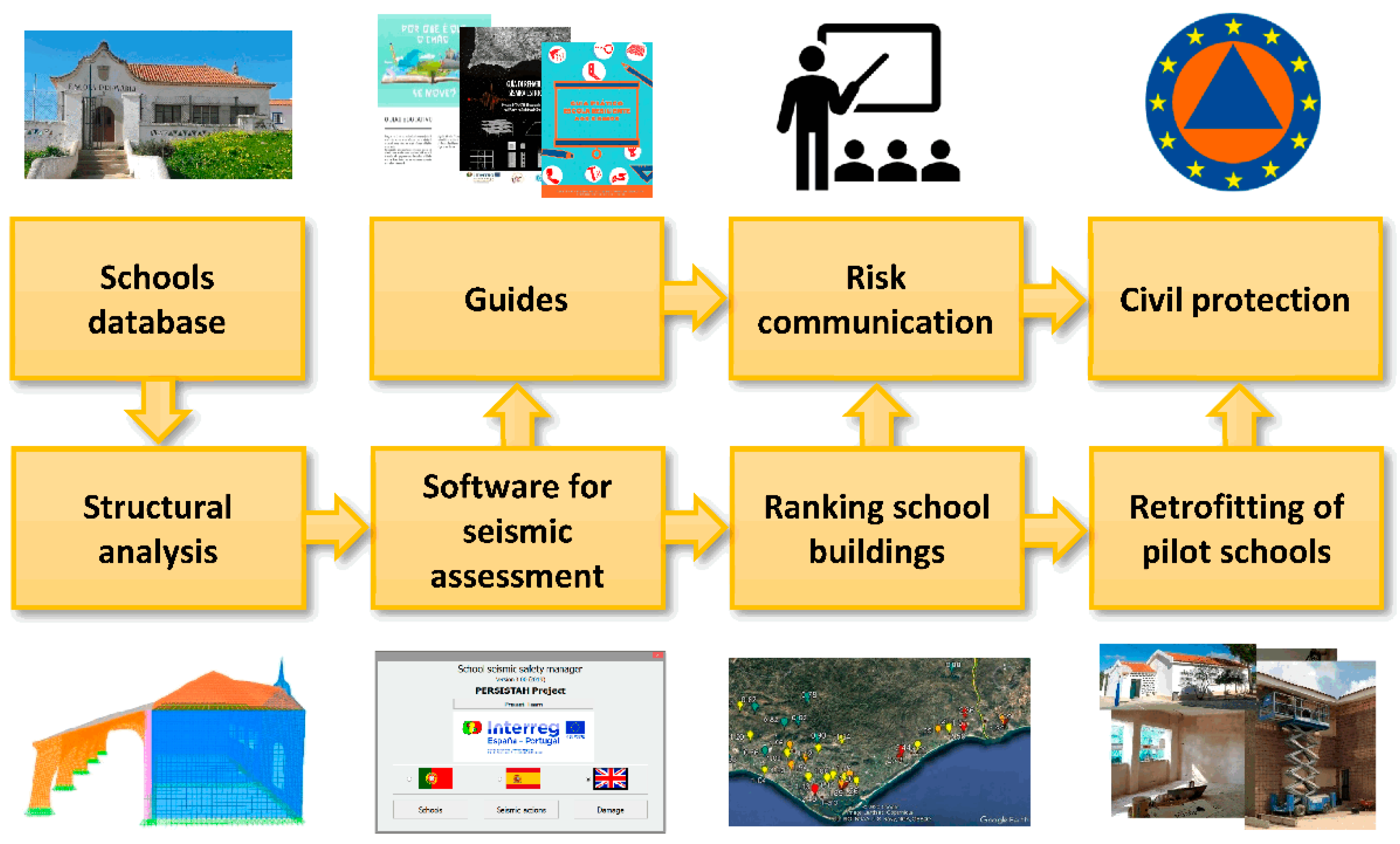

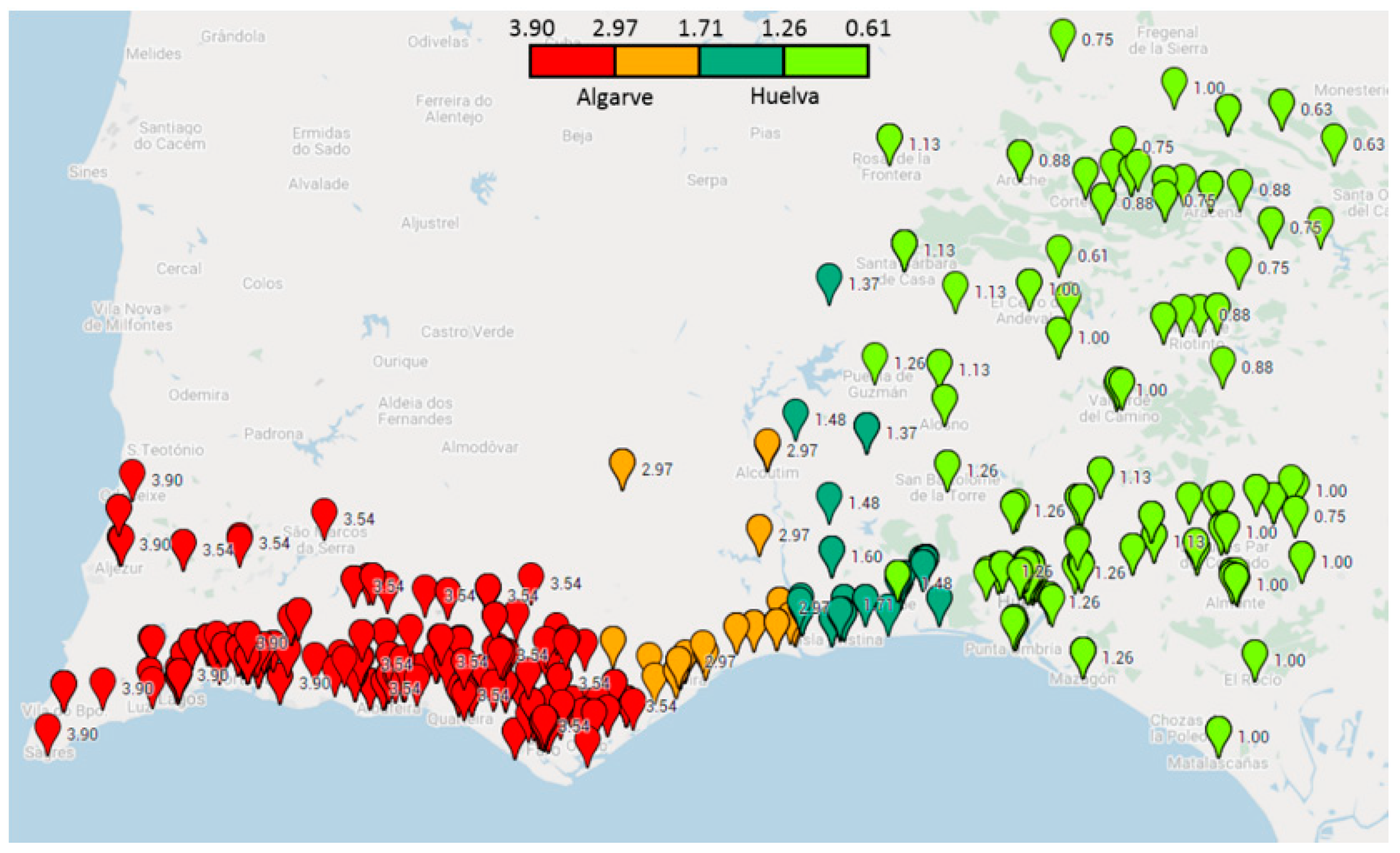
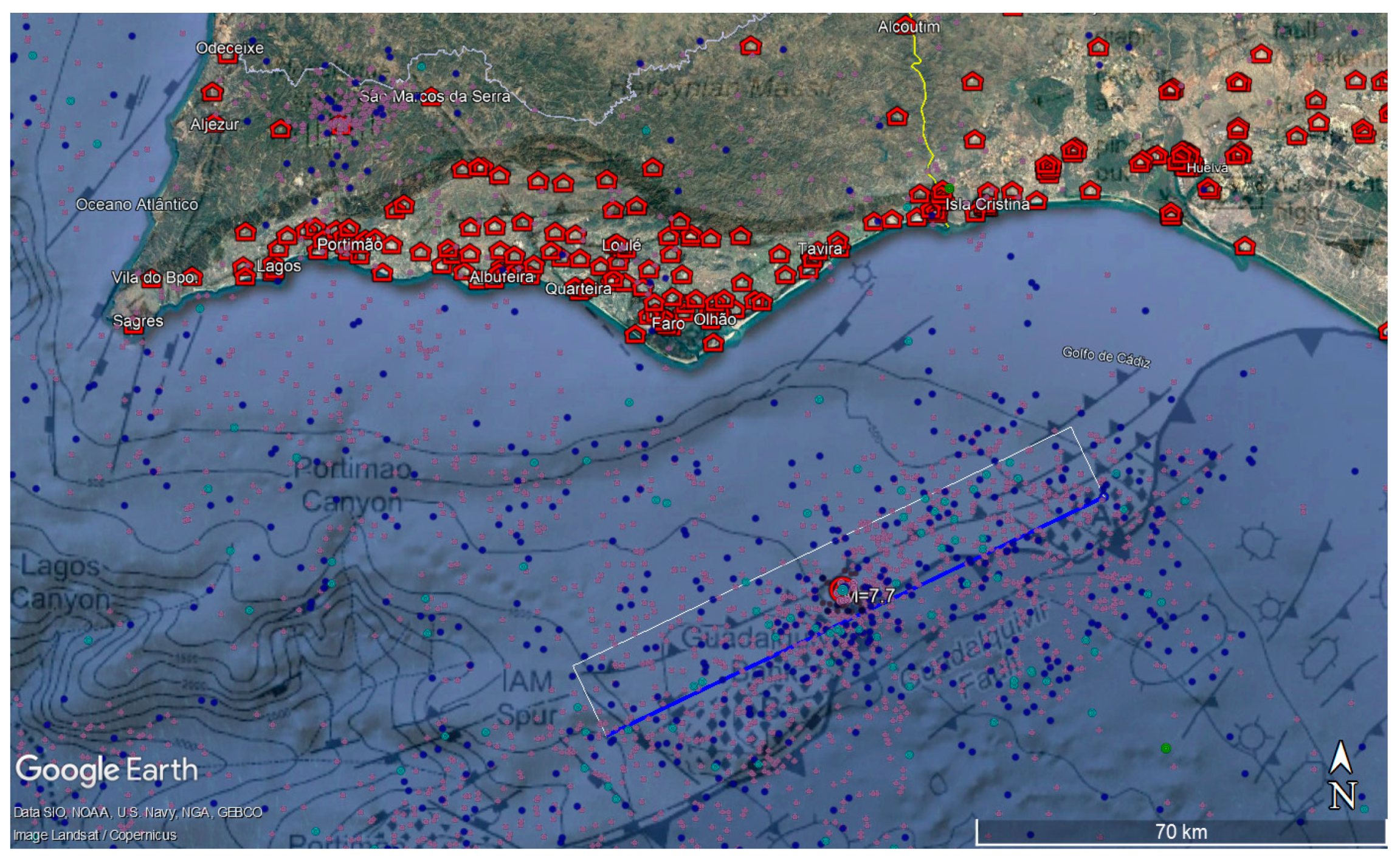


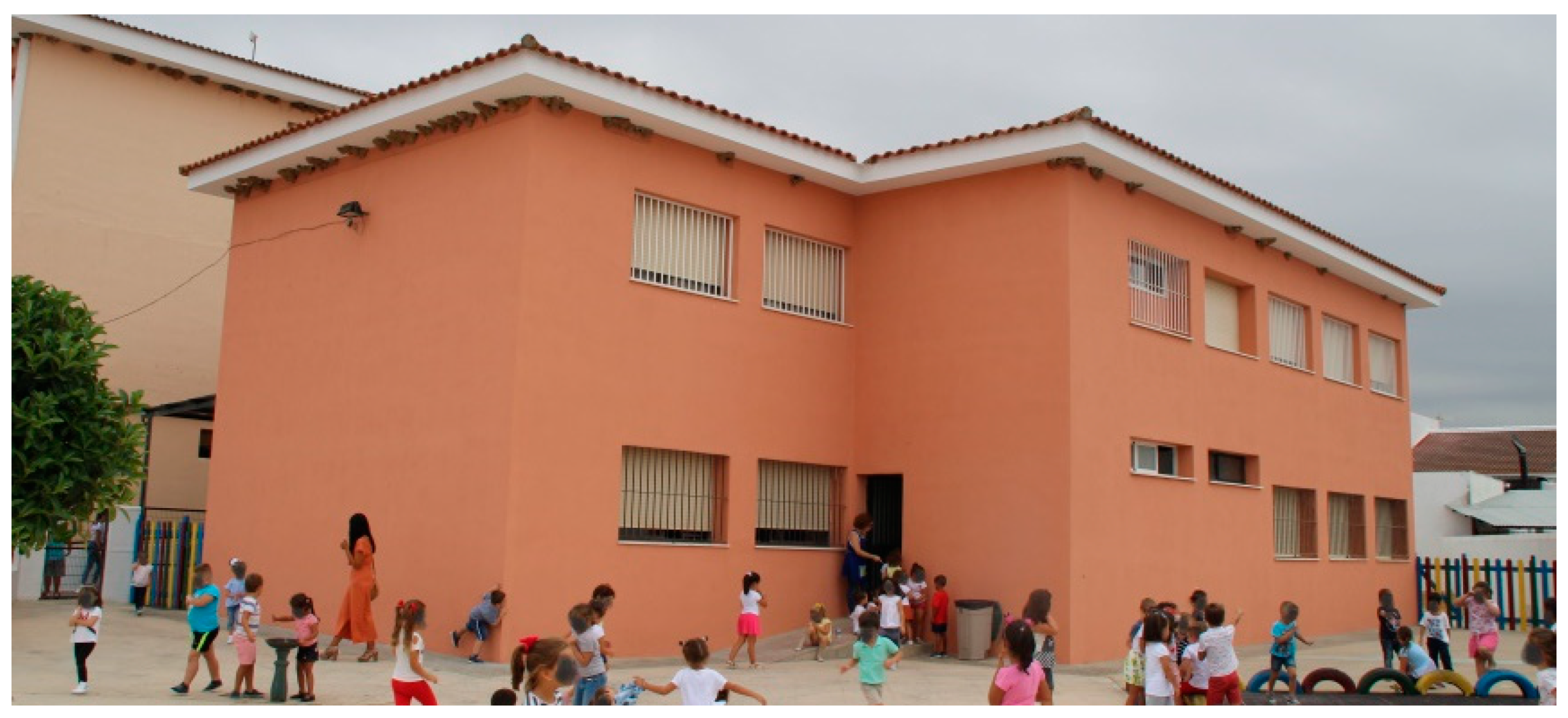
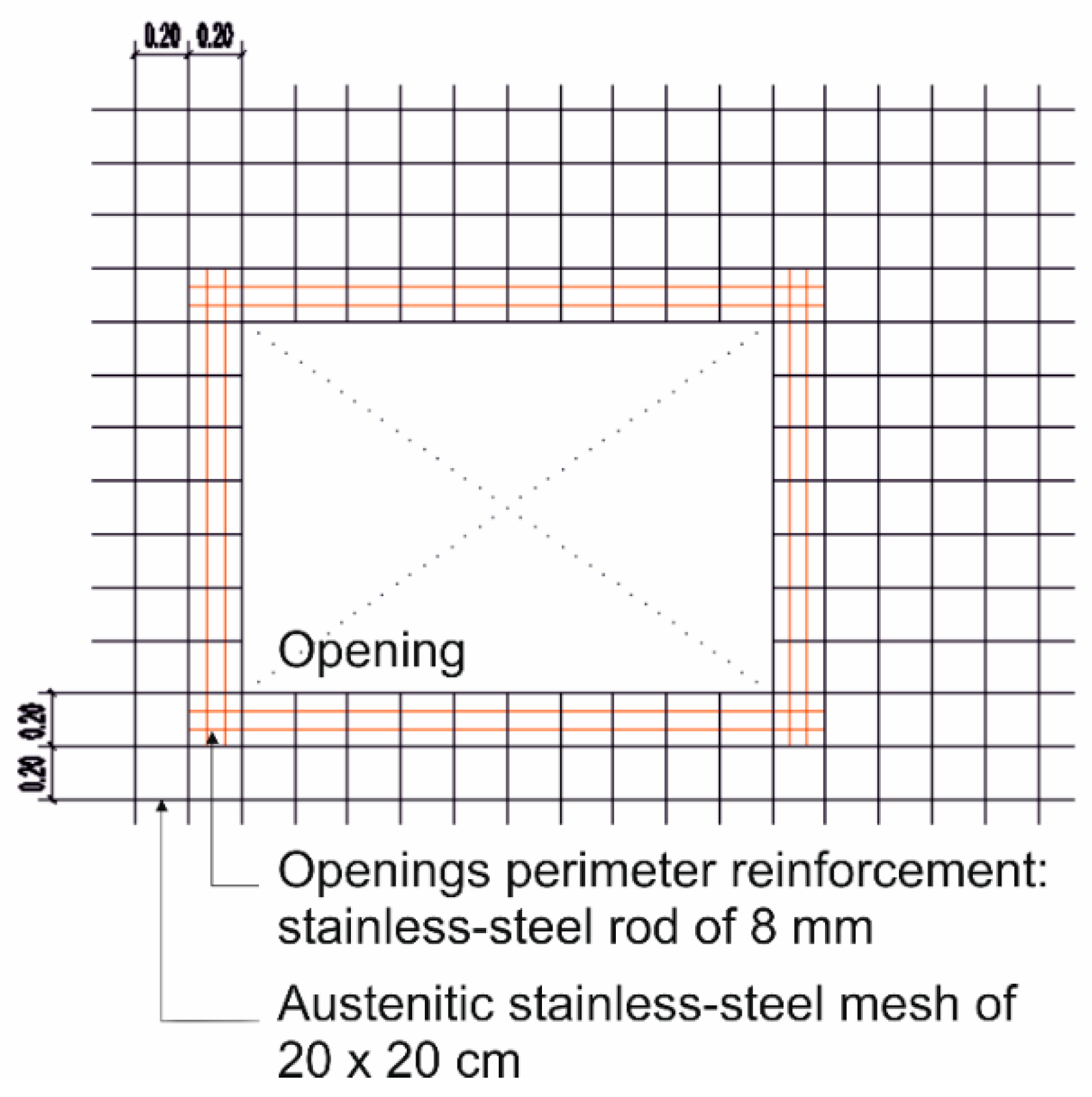

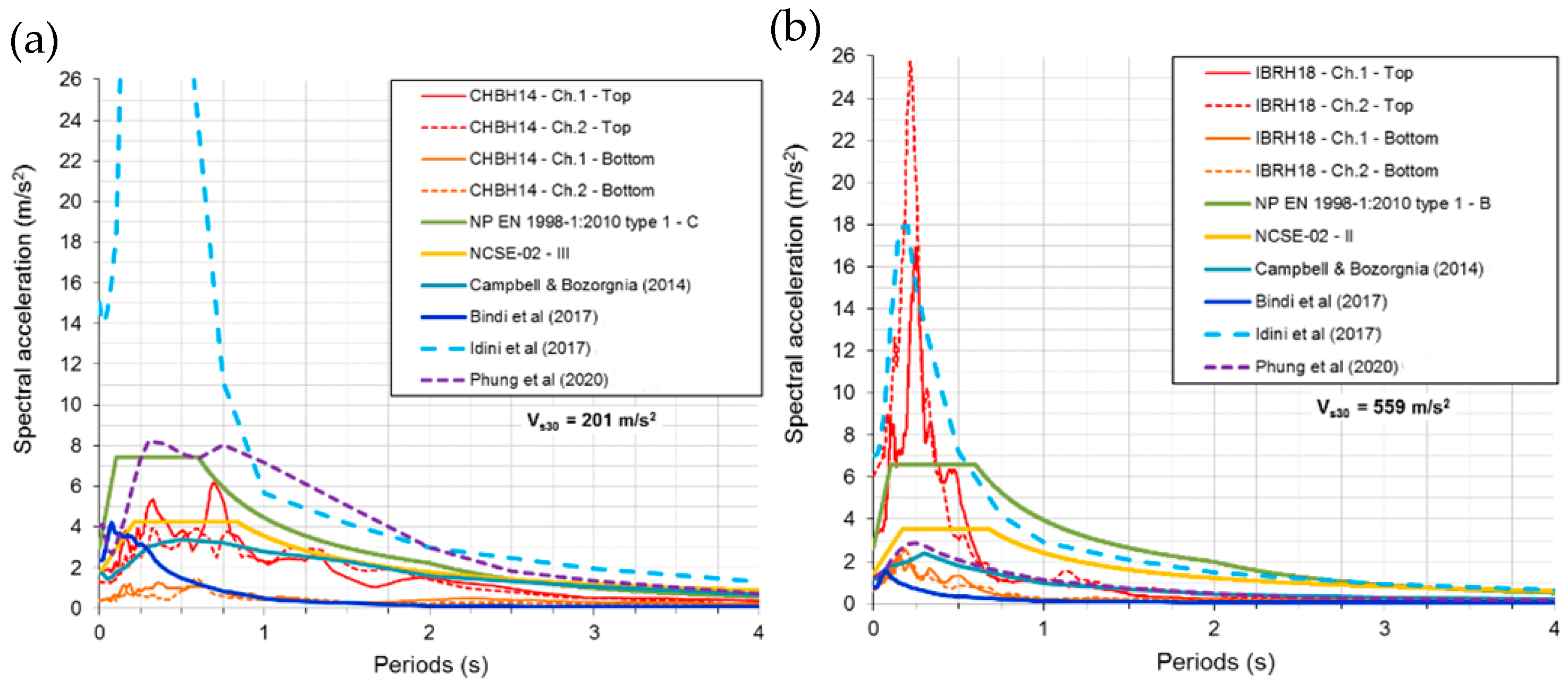
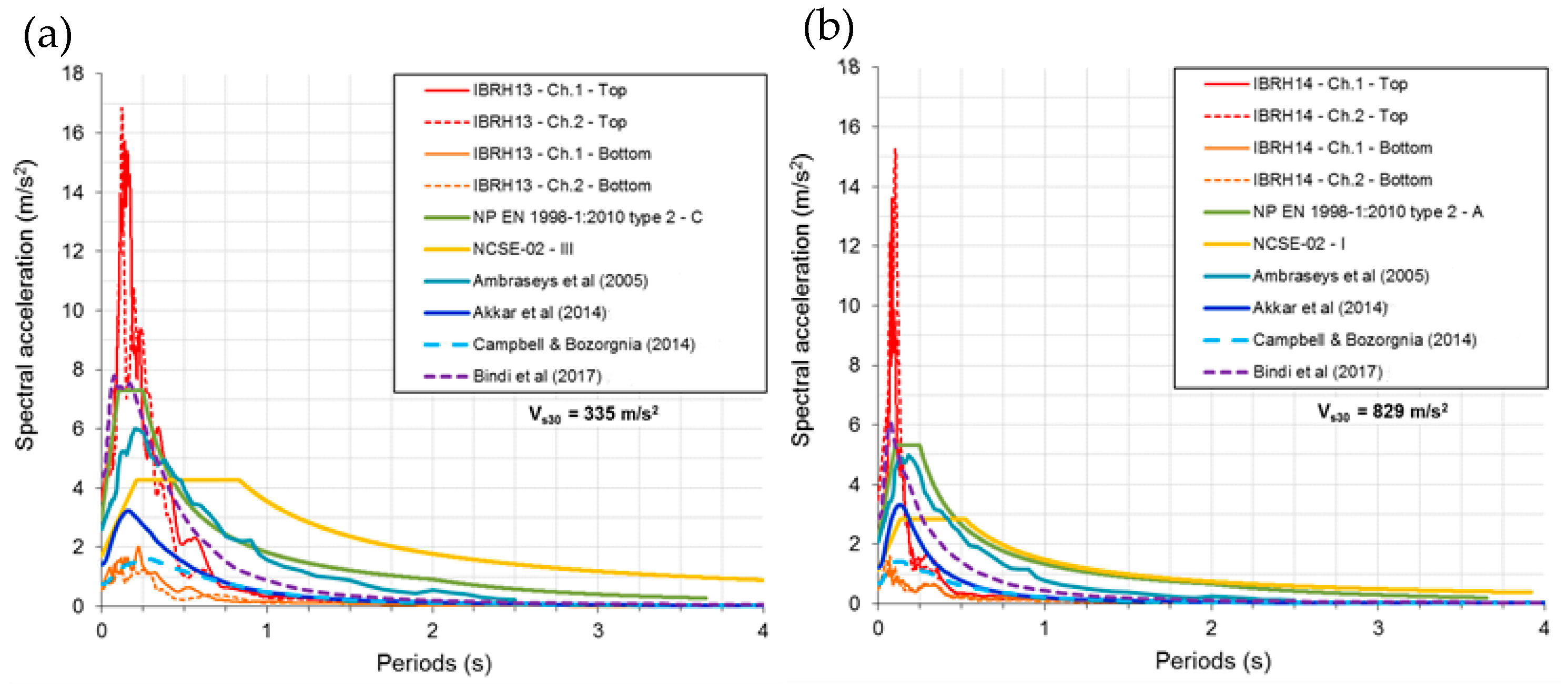
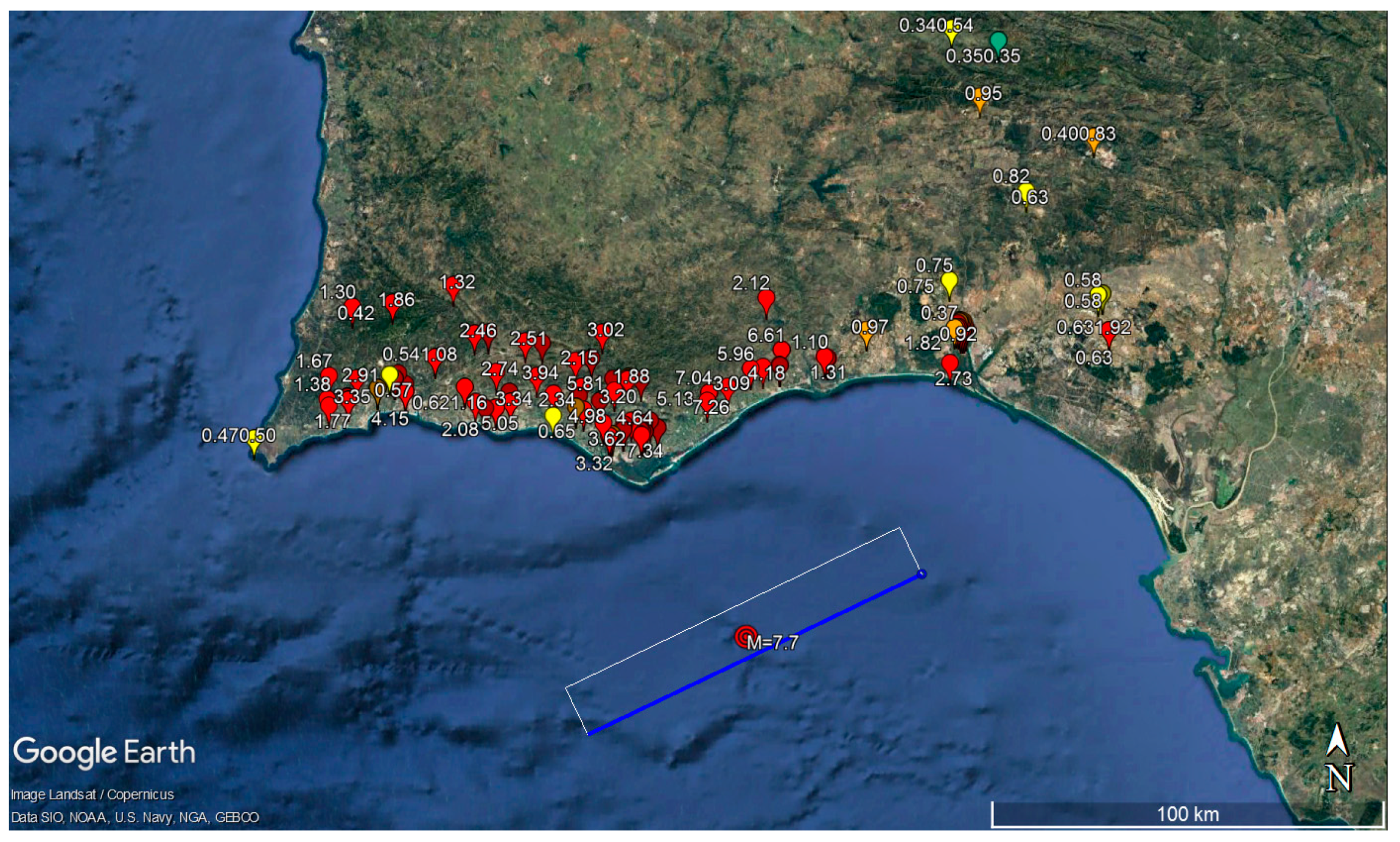
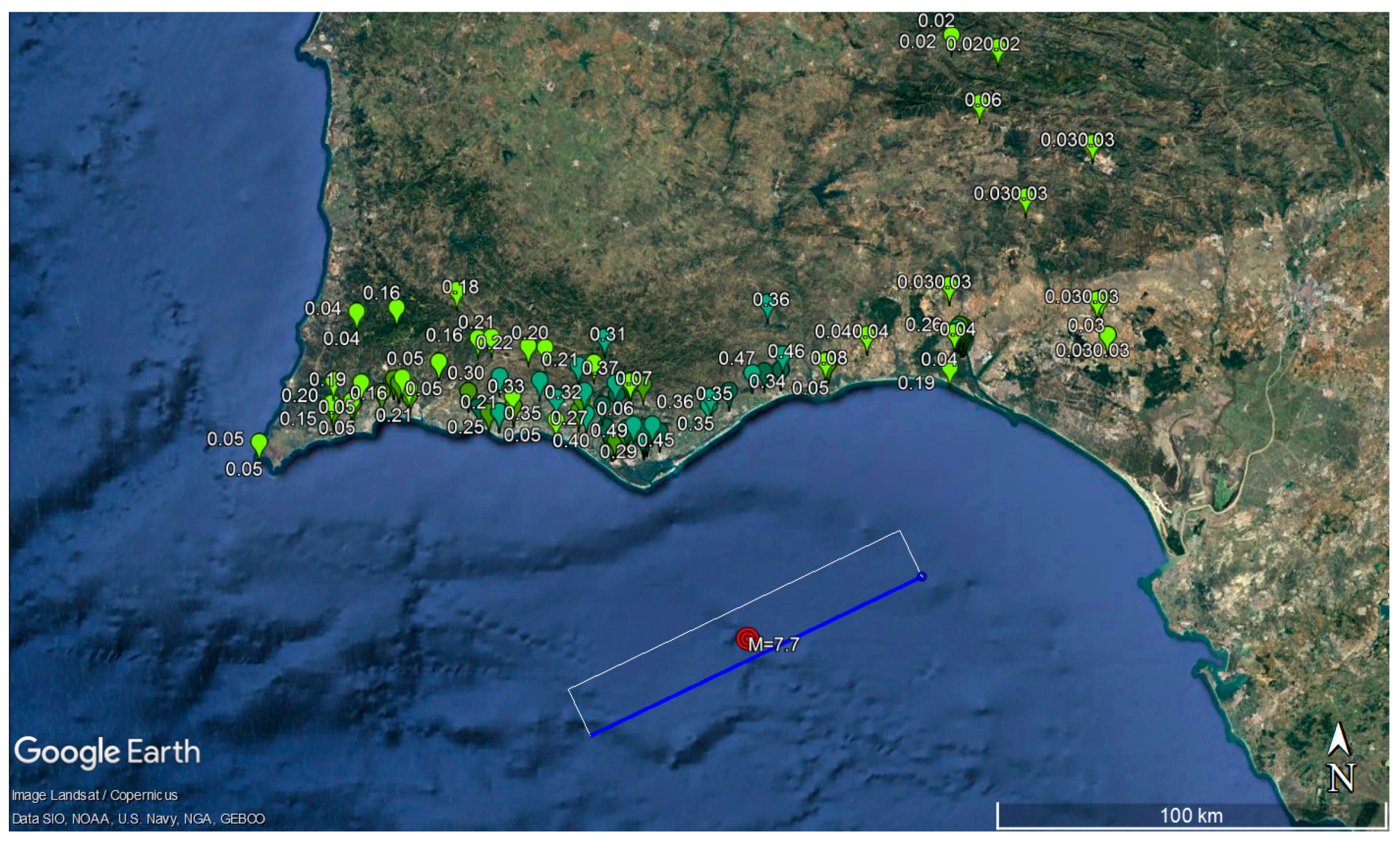

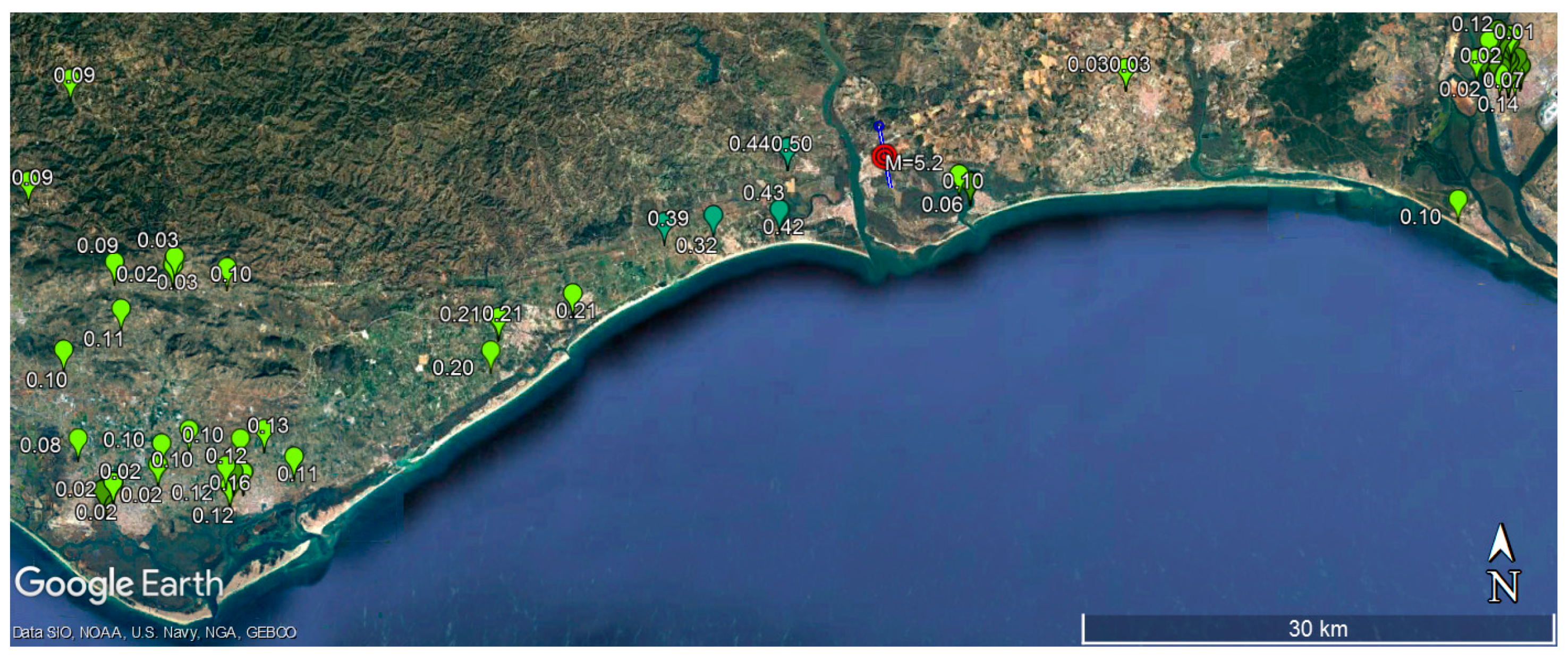
Publisher’s Note: MDPI stays neutral with regard to jurisdictional claims in published maps and institutional affiliations. |
© 2022 by the authors. Licensee MDPI, Basel, Switzerland. This article is an open access article distributed under the terms and conditions of the Creative Commons Attribution (CC BY) license (https://creativecommons.org/licenses/by/4.0/).
Share and Cite
Estêvão, J.M.C.; Morales-Esteban, A.; Sá, L.F.; Ferreira, M.A.; Tomás, B.; Esteves, C.; Barreto, V.; Carreira, A.; Braga, A.; Requena-Garcia-Cruz, M.-V.; et al. Improving the Earthquake Resilience of Primary Schools in the Border Regions of Neighbouring Countries. Sustainability 2022, 14, 15976. https://doi.org/10.3390/su142315976
Estêvão JMC, Morales-Esteban A, Sá LF, Ferreira MA, Tomás B, Esteves C, Barreto V, Carreira A, Braga A, Requena-Garcia-Cruz M-V, et al. Improving the Earthquake Resilience of Primary Schools in the Border Regions of Neighbouring Countries. Sustainability. 2022; 14(23):15976. https://doi.org/10.3390/su142315976
Chicago/Turabian StyleEstêvão, João M. C., Antonio Morales-Esteban, Luis F. Sá, Mónica A. Ferreira, Bruno Tomás, Carlos Esteves, Vítor Barreto, Ana Carreira, Alfredo Braga, Maria-Victoria Requena-Garcia-Cruz, and et al. 2022. "Improving the Earthquake Resilience of Primary Schools in the Border Regions of Neighbouring Countries" Sustainability 14, no. 23: 15976. https://doi.org/10.3390/su142315976








